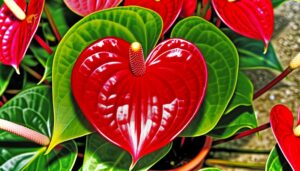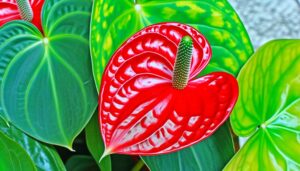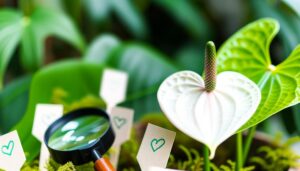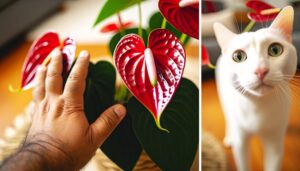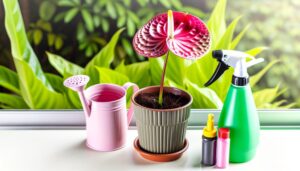Comprehensive Care Guide for Anthurium Black Diamond
For your Anthurium Black Diamond, use a soil mix of equal parts peat moss, perlite, and pine bark. Place it in bright, indirect light, and avoid direct sunlight.
Maintain temperatures between 65°F and 80°F, with humidity levels between 60% and 80%. Water when the top 1-2 inches of soil are dry, reducing in winter.
Isolate new plants to prevent pests and treat issues like aphids or fungal infections promptly. Repot in spring or early summer with care.
Propagate through division or stem cuttings in well-draining mix. Stick with these guidelines and you’ll master the finer details ahead.
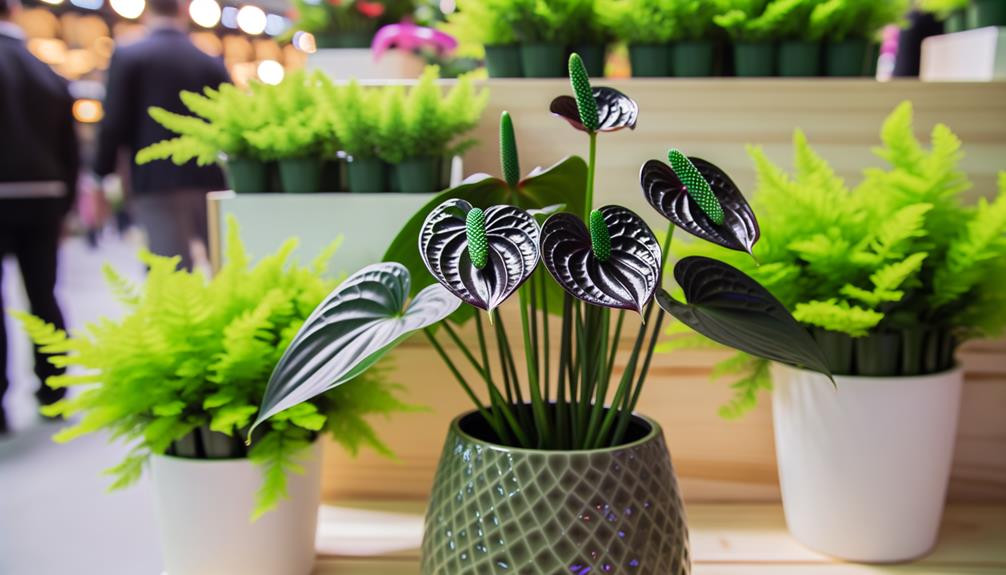
Key Takeaways
- Use a well-draining soil mix with equal parts peat moss, perlite, and pine bark.
- Position the plant in bright, indirect light and avoid direct sunlight.
- Maintain temperatures between 65°F and 80°F and humidity levels between 60% and 80%.
- Water when the top 1-2 inches of soil are dry, reducing frequency in winter.
- Treat pests like aphids and spider mites with insecticidal soap or neem oil.
Choosing the Right Soil
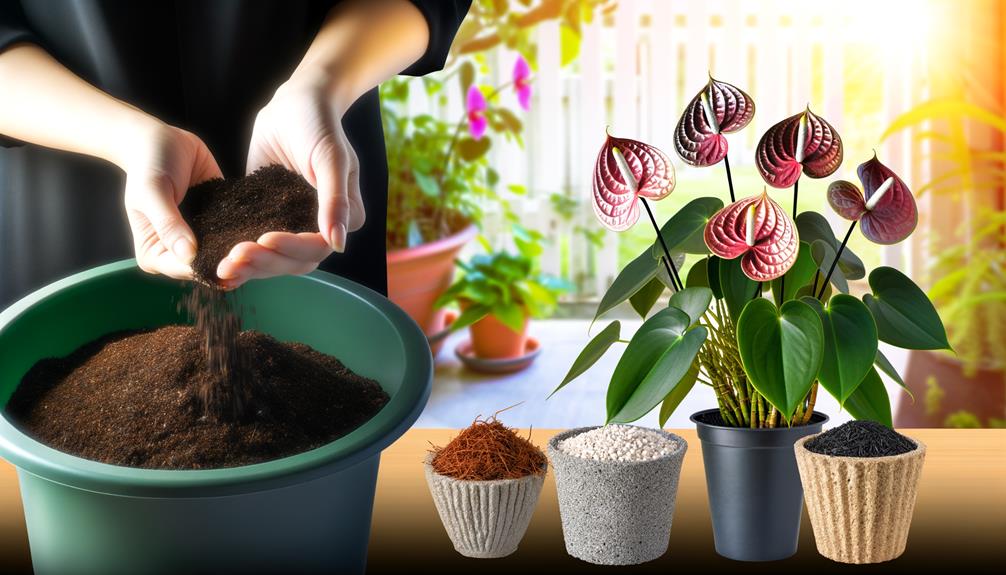
To set the stage for your Anthurium Black Diamond to thrive, it’s crucial to choose a well-draining soil mix rich in organic matter. Begin by selecting a blend that includes peat moss, perlite, and pine bark.
Peat moss retains moisture without becoming waterlogged, while perlite ensures proper aeration. Pine bark adds essential organic material, promoting nutrient absorption. Mix these components in equal parts to create an ideal environment for your plant’s roots.
Test the mixture by watering it; it should remain moist but not soggy. Regularly check for compaction and refresh it annually to maintain prime conditions.
Optimal Light Conditions
Understanding the best light conditions for your Anthurium Black Diamond is essential for ensuring its vibrant growth and overall health. Position your plant in a spot where it can receive bright, indirect light.
Direct sunlight can scorch its leaves, so avoid placing it in intense, direct sunlight. Filtered light through sheer curtains works wonders.
If you notice the leaves turning yellow, it could indicate too much light, while a lack of growth or dark, leggy stems might signal insufficient light.
Consider using a grow light if natural light is limited in your space. Aim for consistency; sudden changes in light conditions can stress the plant.
With careful monitoring, you’ll create the perfect lighting environment for your Anthurium Black Diamond.
Ideal Temperature Range

Maintaining the right temperature range is just as important as providing ideal light conditions for your Anthurium Black Diamond.
Aim for a consistent temperature between 65°F and 80°F (18°C to 27°C). This range mimics its natural tropical habitat and fosters peak growth.
Ensure nighttime temperatures don’t drop below 60°F (15°C), as cooler conditions can stress the plant.
Avoid placing your Anthurium near drafts, air conditioners, or heaters, as sudden temperature fluctuations can hinder its development. A steady, moderate climate allows the plant to thrive.
Humidity Requirements
Given its tropical origins, your Anthurium Black Diamond thrives best in environments with high humidity levels, ideally between 60% and 80%.
Achieving this can be straightforward with a few strategic steps:
- Humidifier: Place a humidifier near your plant to maintain consistent humidity. This is particularly useful in dry climates or during winter months.
- Pebble Tray: Set your plant pot on a tray filled with water and pebbles. As the water evaporates, it increases the humidity around the plant.
- Grouping Plants: Group your Anthurium with other humidity-loving plants to create a microenvironment that boosts overall moisture levels.
- Misting: Regularly mist your plant with water to mimic the natural humidity it craves, but make sure the leaves dry to prevent mold.
These methods will keep your Anthurium Black Diamond flourishing.
Watering Schedule

To secure the health of your Anthurium Black Diamond, water it thoroughly when the top 1-2 inches of soil feel dry to the touch. Use your finger to test the soil‘s moisture. If it feels arid, it’s time to water.
Confirm the water drains completely, as stagnant water can lead to root rot. Choose lukewarm water to avoid shocking the plant. Water gradually, allowing the soil to absorb moisture uniformly.
Monitor the plant’s response; if leaves yellow, you’re overwatering. If they curl, you’re underwatering. Adjust accordingly. During winter, reduce watering frequency, as growth slows.
Keep a consistent schedule, but remain flexible, adapting to your plant’s unique needs and environment. This attentive approach secures adequate hydration and vibrant growth.
Fertilization Tips
As you ensure proper hydration for your Anthurium Black Diamond, it’s equally important to provide it with the right nutrients through careful fertilization. Aim for a balanced, water-soluble fertilizer to keep your plant thriving.
Here’s a systematic approach:
- Frequency: Fertilize every 6-8 weeks during the growing season (spring and summer) for best growth.
- Dilution: Use a half-strength solution to avoid over-fertilization, which can damage the roots.
- Application: Apply the fertilizer evenly around the soil, ensuring it reaches the root zone without touching the foliage.
- Observation: Monitor for signs of nutrient deficiency or excess, such as yellowing leaves or burnt tips, and adjust accordingly.
Pruning and Maintenance
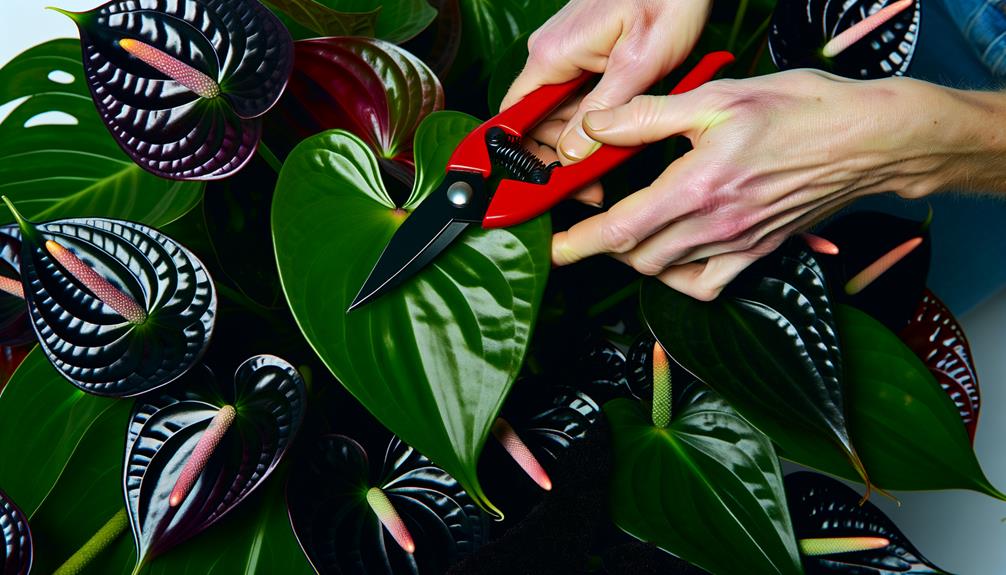
Regular trimming and maintenance are crucial for keeping your Anthurium Black Diamond healthy and visually attractive.
Start by eliminating any dead or yellowing leaves using clean, sharp scissors. This prevents disease and encourages new growth.
Trim faded flowers to redirect the plant’s energy towards developing blooms. Inspect your plant weekly, paying close attention to the lower leaves and stems. Remove any debris from the soil surface to discourage mold growth.
Gently wipe the leaves with a damp cloth to maintain their shiny appearance and enhance photosynthesis.
Make sure your trimming tools are sterilized before use to prevent introducing pathogens.
Pest Control Strategies
When it comes to keeping your Anthurium Black Diamond healthy, understanding pest control strategies is essential. Start by identifying common pests like aphids, spider mites, and mealybugs that could harm your plant.
Then, explore natural pest remedies and establish a routine for prevention and maintenance to keep these invaders at bay.
Identifying Common Pests
Identifying common pests that target your Anthurium Black Diamond involves closely inspecting the leaves, stems, and soil for signs of infestation, such as discolored spots, wilting, or visible insects. Be meticulous in your examination to catch issues early.
- Spider Mites: Look for tiny, web-like structures on the undersides of leaves and small, moving dots.
- Mealybugs: Check for cotton-like masses in leaf axils and on stems.
- Aphids: Notice clusters of small, soft-bodied insects on new growth and the sticky residue (honeydew) they leave behind.
- Fungus Gnats: Inspect the soil surface for small, black flies and larvae feeding on organic material.
Natural Pest Remedies
To effectively manage pests on your Anthurium Black Diamond using natural remedies, start by incorporating beneficial insects such as ladybugs and predatory mites into your plant care routine. These insects can significantly reduce pest populations without harming your plant.
Additionally, consider using neem oil or insecticidal soap, which are both effective and gentle on your Anthurium.
| Natural Remedy | Benefits |
|---|---|
| Ladybugs | Control aphids and spider mites |
| Predatory Mites | Target spider mites specifically |
| Neem Oil | Acts as a broad-spectrum insecticide |
| Insecticidal Soap | Disrupts the cell membranes of pests |
| Diatomaceous Earth | Dehydrates and kills soft-bodied pests |
Prevention and Maintenance
Regularly examining your Anthurium Black Diamond for early signs of pest activity and promptly addressing any issues is crucial for maintaining the plant’s health and preventing infestations.
To keep pests at bay, follow these detailed, methodical steps:
- Check Weekly: Examine the leaves, stems, and soil for signs of insects or eggs. Look for discoloration, holes, or sticky residue.
- Cleanse Leaves: Gently wipe the leaves with a damp cloth to remove dust and potential pests. This also aids in better respiration for your plant.
- Apply Neem Oil: Use neem oil as a natural insect repellent. Dilute it with water and spray it on the plant’s surfaces.
- Isolate New Plants: Quarantine new additions for a few weeks to verify they’re pest-free before integrating them into your collection.
Consistent attention guarantees a thriving Anthurium Black Diamond.
Common Diseases

When caring for your Anthurium Black Diamond, you’ll need to be vigilant about common diseases, particularly fungal infections and pest infestations.
Fungal issues often arise from overwatering and poor ventilation, while pests like spider mites and aphids can invade and damage the plant.
Understanding the symptoms and preventive measures for both will help maintain your plant’s health.
Fungal Infections
Fungal infections, such as root rot and leaf spot, can severely impact the health of your Anthurium Black Diamond if not promptly identified and treated.
To effectively manage these infections, follow these steps:
- Identify Symptoms: Look for yellowing leaves, black spots, and wilting. Early detection is crucial.
- Improve Drainage: Guarantee your plant’s soil drains well. Overwatering is a common cause of root rot.
- Increase Air Circulation: Place your Anthurium in a spot with good airflow to reduce humidity around the plant.
- Use Fungicides: Apply an appropriate fungicide to affected areas. Follow the product’s guidelines carefully to avoid harming your plant.
Pest Infestations
Just as fungal infections pose a threat to your Anthurium Black Diamond, pest infestations can also undermine its health and essentiality.
Aphids, mealybugs, and spider mites are among the common culprits. You’ll notice these pests by their telltale signs: sticky residue, cotton-like masses, or tiny webs.
Inspect your plant regularly, paying close attention to the undersides of leaves and new growth. If you find pests, isolate the affected plant immediately. Use insecticidal soap or neem oil for treatment. Apply methodically, ensuring thorough coverage.
Repeat treatments every 7-10 days until all signs of infestation are gone. Don’t forget to check the surrounding plants, as pests can easily spread. Your vigilance is key to maintaining a healthy Anthurium Black Diamond.
Repotting Guide
Repotting your Anthurium Black Diamond is crucial for maintaining its health and encouraging robust growth.
Follow these steps to guarantee a smooth process:
- Choose the Right Time: Repot during spring or early summer when the plant is actively growing.
- Select a Suitable Pot: Opt for a pot 1-2 inches larger in diameter than the current one, guaranteeing it has proper drainage holes.
- Prepare the Soil Mix: Use a well-draining mix of orchid bark, perlite, and peat moss to mimic the plant’s natural habitat.
- Transplant with Care: Gently remove the plant from its old pot, untangle roots, and place it in the new pot without damaging the root system.
Propagation Methods

To propagate your Anthurium Black Diamond, you’ll want to focus on two primary methods: division and stem cuttings.
For division, gently remove the plant from its pot and carefully separate the root clumps. Make sure each section has roots and at least one stem. Replant these divisions in fresh, well-draining soil.
Stem cuttings require you to snip a healthy stem with a few leaves. Allow the cut end to callous for a day. Then, plant it in a moist, sterile potting mix. Cover the pot with plastic to maintain humidity and place it in indirect light. Keep the soil lightly moist and be patient; roots will form in a few weeks.
Happy propagating!
Conclusion
By following this thorough guide, you’ll guarantee your Anthurium Black Diamond thrives.
Consider Jane, a hypothetical plant enthusiast, who transformed her struggling plant by adjusting the humidity and repotting it with the appropriate soil mix.
Her Anthurium now boasts vibrant, glossy leaves and stunning black blooms.
Your attention to detail in soil, light, temperature, humidity, watering, and pest control will yield similar results, making your plant care journey both successful and rewarding.

